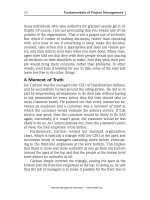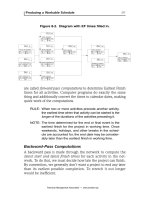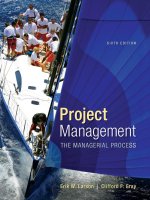Exploring management 6th by schermerhornch09
Bạn đang xem bản rút gọn của tài liệu. Xem và tải ngay bản đầy đủ của tài liệu tại đây (616.79 KB, 34 trang )
Exploring Management
John Schermerhorn, Jr. and Daniel G. Bachrach
Sixth Edition
Chapter 9
Organizational Cultures,
Innovation, and Change
“…we’re very clear not everyone fits in this quirky
company. We put potential hires through seven to eight
interviews. Sometimes people look at us like we’re crazy
and run away. When employees don’t understand the
team atmosphere, we let them go…”
--Kip Tindell, CEO of Container Store
Copyright ©2018 John Wiley & Sons, Inc.
2
Your Chapter 9 Takeaways
• What is the nature of organizational culture? (9.1)
• How do organizations support and achieve innovation? (9.2)
• How do manages lead the processes of organizational change? (9.3)
Copyright ©2018 John Wiley & Sons, Inc.
3
ORGANIZATIONAL CULTURE 9.1
Takeaway 9.1 – answers to come
• Organizational culture is the personality of the organization.
• Organizational culture shapes behavior and influences performance.
• Not all organizational cultures are alike.
• The observable culture is what you see and hear as an employee or customer.
• The core culture is found in the underlying values of the organization.
• Value-based management supports a strong organizational culture.
Copyright ©2018 John Wiley & Sons, Inc.
4
ORGANIZATIONAL CULTURE 9.1
Organizational Culture
• Culture is the personality of the organization
• Shared beliefs and values that develops in an organization and
guides the behavior of its members
Copyright ©2018 John Wiley & Sons, Inc.
5
ORGANIZATIONAL CULTURE 9.1
Strong Cultures
• Organizational culture shapes behavior and influences performance
• Strong cultures are clear, well-defined, and widely shared among
members
• Socialization helps new members learn the culture
Copyright ©2018 John Wiley & Sons, Inc.
6
ORGANIZATIONAL CULTURE 9.1
Organizational Cultures
Copyright ©2018 John Wiley & Sons, Inc.
7
ORGANIZATIONAL CULTURE 9.1
Observable Culture
• what you see and hear as an employee or customer
Figure 9.1 FIGURE 9.1 What Are the Main Components of Organizational Culture?
Copyright ©2018 John Wiley & Sons, Inc.
8
ORGANIZATIONAL CULTURE 9.1
Organizational Culture
• Core culture is found in the underlying values of the organization.
• Core values are the beliefs that shape behavior.
Copyright ©2018 John Wiley & Sons, Inc.
9
ORGANIZATIONAL CULTURE 9.1
Value-Based Management
• Values-based management actively develops, communicates, and enacts shared
values.
• Workplace spirituality involves creating meaning and community for employees.
• Common elements are meaningful work, respect for diversity, work/life balance,
and ethical behavior
• Symbolic leaders model and teach the culture and values.
Copyright ©2018 John Wiley & Sons, Inc.
10
ORGANIZATIONAL CULTURE 9.1
Study Guide for Takeaway 9.1
Rapid Review:
•
Organizational culture is a climate of shared values and beliefs that guides the behavior of members; it
creates the character and personality of the organization and sets its performance tone.
•
The observable culture is found in the everyday rites, rituals, stories, heroes, and symbols of the
organization.
•
•
The core culture consists of the core values and fundamental beliefs on which the organization is based.
•
Symbolic leadership uses words, symbols, and actions to communicate the organizational culture.
Value-based management communicates, models, and reinforces core values throughout the
organization.
Copyright ©2018 John Wiley & Sons, Inc.
11
ORGANIZATIONAL CULTURE 9.1
Study Guide for Takeaway 9.1
Questions for Discussion:
1.
2.
3.
Can an organization achieve success with a good organizational design but a weak
organizational culture?
When you are in your local bank or any other retail establishment as a customer,
what do you see and hear around you that identifies its observable culture?
What core values would you choose if you were creating a new organization and
wanted to establish a strong performance-oriented culture?
Copyright ©2018 John Wiley & Sons, Inc.
12
ORGANIZATIONAL CULTURE 9.1
Be Sure You Can…for Takeaway 9.1
• explain organizational culture as the personality of an organization.
• describe how strong cultures influence organizations.
• define and explain the process of socialization.
• distinguish between the observable and the core cultures.
• explain value-based management.
• explain symbolic leadership.
Copyright ©2018 John Wiley & Sons, Inc.
13
HOW ORGANIZATIONS ACHIEVE INNOVATION 9.2
Takeaway 9.2 – answers to come
•
•
•
•
•
•
Organizations pursue process, product, and business model innovations.
Green innovations advance the goals of sustainability.
Social innovations seek solutions to important societal problems.
Commercializing innovation turns new ideas into salable products.
Disruptive innovation uses new technologies to displace existing practices.
Innovative organizations share many common characteristics.
Copyright ©2018 John Wiley & Sons, Inc.
14
HOW ORGANIZATIONS ACHIEVE INNOVATION 9.2
Types of Innovation
• Innovation – taking a new idea and putting it into practice
• Process innovation results in better ways to do things.
• Product innovation results in new or improved goods or services.
• Business model innovations are new ways to make money.
Copyright ©2018 John Wiley & Sons, Inc.
15
HOW ORGANIZATIONS ACHIEVE INNOVATION 9.2
Types of Innovation
• Green innovations
• Earth friendly business models
• Social innovations
• Business models that help solve the world’s social problems
• Social Entrepreneurship
• Ways to solve social problems
Copyright ©2018 John Wiley & Sons, Inc.
16
HOW ORGANIZATIONS ACHIEVE INNOVATION 9.2
Commercializing Innovation
• Commercializing innovation
•
Turns ideas into products, services, or processes
Figure 9.2 How Do Organizations Commercialize Innovation?
Copyright ©2018 John Wiley & Sons, Inc.
17
HOW ORGANIZATIONS ACHIEVE INNOVATION 9.2
Commercializing Innovation
• Reverse innovation
• takes products created for small or emerging markets and moves them into
larger distribution
• Disruptive innovation
• the creation of an innovative product or service that starts out small scale and
then moves “up market” to where it is so widely used it displaces prior practices
and competitors
Copyright ©2018 John Wiley & Sons, Inc.
18
HOW ORGANIZATIONS ACHIEVE INNOVATION 9.2
Innovative Organizations
Copyright ©2018 John Wiley & Sons, Inc.
19
HOW ORGANIZATIONS ACHIEVE INNOVATION 9.2
Study Guide for Takeaway 9.2
Rapid Review:
•
Innovation is a process that turns creative ideas into products or processes that benefit organizations
and their customers.
•
•
•
•
•
Organizations pursue process, product, and business model innovations.
Organizations pursue green innovations that support sustainability.
Organizations pursue social business innovations to tackle important societal problems.
The process of commercializing innovation turns new ideas into useful applications.
Highly innovative organizations tend to have supportive cultures, strategies, structures, staffing, and
top management.
Copyright ©2018 John Wiley & Sons, Inc.
20
HOW ORGANIZATIONS ACHIEVE INNOVATION 9.2
Study Guide for Takeaway 9.2
Questions for Discussion:
1.
2.
3.
Are there any potential downsides to making organizational commitments to green
innovation?
What are the biggest trouble points in a large organization that might prevent a
great idea from becoming a commercialized innovation?
What difference does a leader make in terms of how innovative an organization
becomes?
Copyright ©2018 John Wiley & Sons, Inc.
21
HOW ORGANIZATIONS ACHIEVE INNOVATION 9.2
Be Sure You Can…for Takeaway 9.2
• discuss differences among process, product, and business model innovations.
• explain green innovation and social business innovation.
• list five steps in the process of commercializing innovation.
• list and explain four characteristics of innovative organizations.
Copyright ©2018 John Wiley & Sons, Inc.
22
ORGANIZATIONAL CHANGE 9.3
Takeaway 9.3 – answers to come
•
•
•
•
•
•
Organizations and teams need change leaders
Organizational change can be transformational or incremental
Three phases of planned change are unfreezing, changing, and refreezing.
Times of complexity require improvising in the change process
Managers use force-coercion, rational persuasion, and shared power change strategies.
Change leaders identify and deal positively with resistance to change.
Copyright ©2018 John Wiley & Sons, Inc.
23
Organizational Change 9.3
Types of Change
• Change leaders
•
Leaders who take responsibility for change
Copyright ©2018 John Wiley & Sons, Inc.
24
Organizational Change 9.3
Types of Change
• Transformational change
• Results in major and comprehensive redirection of the organization
• Incremental change
• Smaller change that aligns systems and practices with strategy
Copyright ©2018 John Wiley & Sons, Inc.
25









